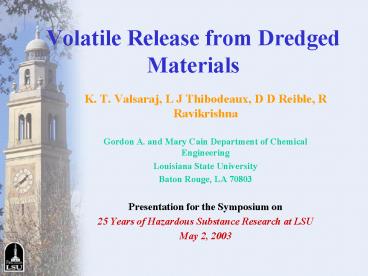Volatile Release from Dredged Materials PowerPoint PPT Presentation
1 / 27
Title: Volatile Release from Dredged Materials
1
Volatile Release from Dredged Materials
- K. T. Valsaraj, L J Thibodeaux, D D Reible, R
Ravikrishna - Gordon A. and Mary Cain Department of Chemical
Engineering - Louisiana State University
- Baton Rouge, LA 70803
- Presentation for the Symposium on
- 25 Years of Hazardous Substance Research at LSU
- May 2, 2003
2
- Background
- Dredging (Navigational and Remedial)
- Storage of Dredged Sediment in Confined Disposal
Facilities (CDFs) - Dredged Material contaminated with Hydrophobic
Organic Compounds (HOCs) (eg Polynuclear
Aromatic Hydrocarbons or PAHs) - Certain PAHs are suspected carcinogens
- Human Exposure Risk due to volatilization of HOCs
from exposed dredged materials in CDFs
3
- Motivation
- Volatilization is a significant mechanism for
contaminant release from CDFs US ACE/WES. - Air concentrations (of PCBs) near CDFs and other
exposed sediment surfaces noted. - Robust models required to predict volatilization
rates of HOCs from exposed sediments in a CDF,
which can be used to assess human exposure risk. - Scarce laboratory or field data are available to
validate existing models.
4
Confined Disposal Facilities (CDFs)
5
Pathways of loss from CDF
During Filling
After Filling
6
- Objectives
- Obtain emission flux data of selected tracer PAHs
in laboratory experiments - Study the effects of various factors on emission
fluxes - air relative humidity, moisture and oil and
grease in sediment, reworking of sediment,
sediment capping, cracks in sediment and sediment
resuspension - Validate mathematical models with the laboratory
data - Obtain flux data from a pilot scale CDF and
compare with model predicted fluxes - Use pilot scale data with an atmospheric
dispersion model to evaluate human exposure risk
7
Contaminant Volatilization - A Conceptual Model
8
Effect of Sediment Moisture Content
9
Effect of Air Relative Humidity
10
Effect of Sediment Reworking
11
Effect of OG on emission
12
Comparison of Flux from Capped and Uncapped
sediments
13
Pilot Scale CDF
- Test conducted at Waterways Experiment Station,
Vicksburg, MS - Dredged material from Indiana Harbor Canal (IHC)
- Periodic flux measurements with modified flux
chamber - Meteorological station to monitor wind speed and
direction, relative humidity and temperature,
soil temperature and soil moisture - Core sample sectioning for concentration and oil
profile - Rainfall simulation over the model CDF
- Reworking of dredged material surface
- Comparison of PHE flux with model
- Application of experimental flux in an
atmospheric dispersion model to assess human
exposure risk
14
Pilot Scale CDF- Experimental Setup
15
Weather and Sediment Parameters - Pilot Scale CDF
16
Experimental and Model Flux - Phenanthrene
17
Resuspension of Sediment During Dredging and in
a CDF
- Significant air concentrations observed at
certain dredging hot spots - No direct measurements of air emissions resulting
from sediment resuspension available - Oscillating grids extensively used to recreate
desired turbulence in water columns - Modified oscillating grid flux chambers designed
to generate desired suspended sediment
concentrations - Flux measurements to air and corresponding
aqueous phase concentrations
18
Resuspension and Volatilization
19
Experimental Set up - Flux measurement
20
Total Suspended Sediment (TSS)
21
Flux to air at different TSS
22
Mass transfer coefficient versus TKE
23
Conclusions
- Is evaporation of HOCs from a CDF important?
- Long term emissions from exposed sediment not
significant after the CDF is completely filled - Emissions are relatively higher in the initial
stages and during reworking - Model - a reliable tool to assess, monitor and
manage exposure risk due to volatilization? - Satisfactory prediction of emission rates by the
model - Useful for siting and emission monitoring
decisions - Models to be included in the ADDAMs suite of the
US Army Corps of Engineers risk assessment
procedure
24
Conclusions
- Laboratory Studies
- Flux is high following exposure and decreases
rapidly to attain a slowly falling pseudo steady
state flux - Emissions at the surface is air-side resistance
controlled initially, progressively becoming
sediment side resistance controlled as surface
depletion occurs - Emission from a dry surfaces are lower than that
from damp or wet surfaces due to differences in
adsorption on the sediment surface - Oil and grease in sediment act as an additional
compartment resulting in increased partitioning
and resultant lower equilibrium concentrations of
the contaminant in the pore spaces - Capping of sediment results in significant
reduction of surface emissions - Satisfactory agreement between model and
experimental data
25
Conclusions
- Pilot Scale Study
- Contaminant flux was high initially and decreased
rapidly - Significant compaction of sediment due to water
evaporation resulted in changes in transport
properties - Reworking of dredged material resulted in
increase of flux - Models used with laboratory data agreed
satisfactorily with the pilot scale phenanthrene
flux data - Atmospheric dispersion models used with pilot
scale flux data showed ambient air concentrations
lower than OSHA regulations for phenanthrene
26
Conclusions
- Resuspension of sediment and dredged materials
- Air Emissions of tracers HOCs were measured from
a sediment suspension generated using an
oscillating grid - Corresponding suspended solids concentrations and
aqueous concentrations of the HOCs measured - Flux to air and water concentrations were
directly proportional to the suspended sediment
concentrations
27
Acknowledgements
- U. S. EPA (HSRC SSW)
- U.S. Army Corps of Engineers
- Graduate Student R Ravikrishna
- Undergraduates Greg, Louis, Toriano, Sonal
- Univ. of Minnesota J Gulliver, J J Orlins
- US ACE C B Price, J M Brannon, S Yost, T Myers

